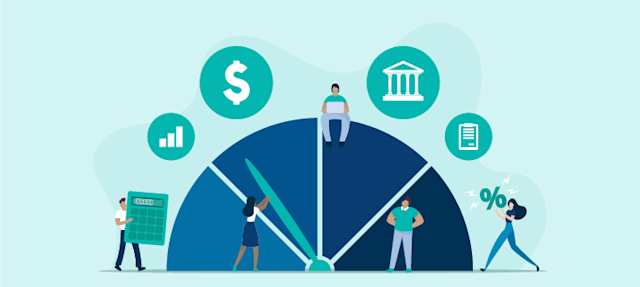What is a FICO Score?

Summary
A FICO score is a credit score lenders use to assess your creditworthiness. Learn how this important number works, how it’s calculated and how it can affect your borrowing power.
In this article:
If you’re looking to apply for a mortgage, take out a loan or even apply for a new credit card, your FICO® Score could be an important part of the process. Here’s why: Many lenders use your FICO Score as a key factor in determining whether to approve you for a loan or line of credit. Your FICO Score is a significant measure of your creditworthiness and could affect your overall cost of borrowing.
Below, we’ll dive deeper into what a FICO Score is, how it works and how to check and potentially improve your credit score if necessary.
How does a FICO Score work?
FICO stands for the Fair Isaac Corporation, and a FICO Score is a three-digit number (ranging from 300 to 850) used by lenders to assess your creditworthiness — how likely you are to repay your loan.
The higher your credit score, the more likely you’ll be approved for personal loans, auto loans, credit cards and mortgages. A higher credit score may also lead to a lower interest rate on a loan or line of credit/credit card and more favorable loan terms.2 Your FICO Score might also be considered when you apply to rent a property3 or sign up for utilities like electricity, water, gas or internet.4
How is FICO different from VantageScore?
VantageScore® is another commonly used credit scoring model (OneMain uses VantageScore). While the FICO Score has been around since 1989, VantageScore was introduced in 2006 by the three major credit bureaus (Equifax, Experian and TransUnion). Since each model calculates scores differently, your FICO Score and VantageScore may not be the same, even if they appear similar. For example, VantageScore gives more weight to the age of your credit accounts than FICO Score does.5
If you’re a OneMain customer, you can check your VantageScore for free through your online account or the OneMain mobile app. You can also track your score’s progress with monthly updates that show how it’s trending over time — a great way to stay on top of your financial picture.
How are FICO Scores calculated?
FICO uses five factors to calculate your credit score,6 including:
- Payment history (35%): On-time payments on your credit cards, loans, mortgage and other credit accounts make up the largest percentage of your FICO Score and can increase your overall credit score. Late or missed payments, on the other hand, may bring your score down.
- Amount of debt owed (30%): The amount of debt owed factors in how much debt you have (in total and on different types of accounts) and how many of your accounts have balances. The amount of debt owed also includes your credit utilization ratio for revolving credit, or how much credit you’re using compared to the total amount available to you (your credit limit). Many credit experts suggest keeping your credit utilization below 30%.7 Finally, the amount of debt owed considers how much you have left to pay on installment accounts like personal loans.
- Length of credit history (15%): The length of your credit history refers to how long your credit accounts have been open. The age of your oldest and newest accounts, the average age of your accounts, how long specific accounts have been open and when you last used your accounts are all considered. A longer credit history could increase your credit score.
- Credit mix (10%): Credit mix refers to the different types of credit accounts you have, from revolving accounts like credit cards to installment accounts like personal loans. Your score may benefit from a mix of credit types.
- New credit (10%): Your FICO Score examines how many new credit accounts you’ve opened recently. When you apply for new credit and the lender makes a hard inquiry, your credit score might decrease temporarily. However, a new credit account may help diversify your credit mix and potentially help increase your credit score.
New credit inquiries typically stay on your credit report for two years, but FICO only considers inquiries from the past 12 months.8
How to check your FICO Score
You can check your FICO Score and get an idea of where your credit status stands through one of these sources:9
- Your bank, credit union, lender or credit card issuer: Ask your financial services providers if they offer credit score monitoring services. Many provide these services to their customers at no charge. If you’re specifically looking for your FICO Score, double-check that this is the scoring model the provider uses.
- myFICO.com: Visit myFICO.com to get your FICO Score. You can choose from a free plan or a more comprehensive paid plan that includes extras like credit monitoring and identity theft insurance.10
- Online credit monitoring services: You could sign up for free credit monitoring services like Credit Karma to check your credit score.
Note that checking your own credit score counts as a soft inquiry, or soft pull, and won’t hurt your credit. Lenders may also check your credit using a soft inquiry to prequalify you for certain offers. However, when a lender performs a hard inquiry to check your credit after you formally apply for a loan or credit card, your credit score might go down temporarily.
It’s also a good idea to keep an eye on your credit report, which contains the information used to calculate your credit score. Through MyAnnualCreditReport.com, you can get a copy of your credit reports from each of the major credit bureaus (Equifax, TransUnion and Experian) once a week for free. Go through each report carefully and note any accounts that you didn’t authorize. Dispute any errors that may be lowering your credit score with the appropriate bureau.
How to improve your FICO Score
Since your FICO Score has a major impact on your ability to take out loans and credit cards, it’s a good idea to take steps to help improve your credit score if necessary. Here are some tips to consider:11
- Pay bills on time: Paying your bills on time, every time, could help boost your credit score. If you’re worried you’ll forget a payment, you can try setting up calendar notifications or payment alerts through your online accounts, as well as automatic payment through your lender.
- Lower your credit utilization ratio: The lower your credit utilization, the better. It’s a good idea to keep your credit utilization ratio below 30%. For example, by paying off debt through the debt snowball method (focusing on paying off your smallest debts first) or the debt avalanche method (prioritizing paying off debts with the highest interest rates first), you might lower your credit utilization ratio and boost your FICO Score.
- Avoid unnecessary new credit applications: Only apply for new lines of credit when it’s necessary. Every time you submit an application and a lender performs a hard credit inquiry, your credit score may temporarily go down by a few points.12
- Keep old accounts open: Even if you don’t use an old credit card or another account, you might want to keep it open. Since the length of your credit history is an important factor, having an older account may potentially help increase your credit score.
- Diversify your credit mix: If you’re trying to build your credit history, it might make sense to apply for a different type of credit than you already have to diversify your credit mix. However, be careful not to take on more debt than you can comfortably repay.
Know your score, grow your options
By regularly keeping an eye on your credit score, you can get an idea of the types of loans and credit cards you might be able to get. You’ll also know whether you need to take steps to improve your score.
With a strong credit score, you could open doors to better opportunities to borrow money and use credit, boosting your purchasing power and helping you achieve your goals.
Sources:
1,2,6 https://www.bankrate.com/personal-finance/credit/what-is-a-fico-score/#what-are-fico-scores
3 https://www.investopedia.com/do-you-need-credit-to-rent-apartment-8600564
4 https://www.experian.com/blogs/ask-experian/do-utility-companies-run-credit-checks/
5 https://www.experian.com/blogs/ask-experian/the-difference-between-vantage-scores-and-fico-scores/
7 https://www.nerdwallet.com/article/finance/30-percent-ideal-credit-utilization-ratio-rule
8 https://www.myfico.com/credit-education/credit-reports/credit-checks-and-inquiries
9 https://www.experian.com/blogs/ask-experian/how-do-you-check-your-credit-score/
10 https://www.myfico.com/
11 https://www.experian.com/blogs/ask-experian/credit-education/improving-credit/improve-credit-score/
12 https://www.experian.com/blogs/ask-experian/does-applying-credit-cards-hurt-credit/
This article is for general education and informational purposes, without any express or implied warranty of any kind, including warranties of accuracy, completeness, or fitness for any purpose and is not intended to be and does not constitute financial, legal, tax, or any other advice. Parties (other than sponsored partners of OneMain Financial (OMF)) referenced in the article are not sponsors of, do not endorse, and are not otherwise affiliated with OMF.


